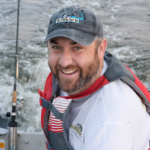The Cape Cod Canal: A Master Class in Adaptation
The Cape Cod Canal remains one of the most dynamic fishing venues in New England, but this year's patterns have thrown experienced anglers a curveball. Unlike previous seasons where massive poppers and oversized jigs dominated the scene, the current abundance of small baitfish—particularly herring fry and whiting—has created a completely different playing field.
The canal's unique character lies in its unpredictability. Historical data shows that fishing success often follows lunar cycles, with the best action typically occurring three to five days after the full moon. However, seasoned anglers know that the canal can "go off at any given time for any given reason," making it both frustrating and exciting for those willing to put in the time.
What makes the current situation particularly interesting is the behavior of both predator and prey. Herring fry (juvenile herring) can be spotted hiding in the rocks, literally in two feet of water right against the canal's edge, while striped bass cruise feet away in zigzag patterns, trying to flush these baitfish from their hiding spots. This creates an incredibly visual fishery where timing and positioning become crucial.
Lure Selection: Small Profile, Big Results
The abundance of small baitfish has necessitated a complete overhaul of traditional lure selection strategies. Gone are the days when throwing big poppers and oversized jigs guaranteed success. Today's smart anglers are downsizing their presentations to match the prevalent forage.
Epoxy Jigs: The New Canal Kings
Epoxy jigs, particularly in the 40-gram (approximately 1.25-ounce) range, have emerged as the go-to lures for the current conditions. These lures offer the perfect balance of castability and versatility. They can be burned across the surface to mimic fleeing baitfish, worked through the water column at various speeds, and even jigged vertically when fish are holding tight to structure.
The beauty of epoxy jigs lies in their ability to handle multiple fishing scenarios. When baitfish are scattered across the surface, a fast retrieve that keeps the jig skipping and dancing on top can trigger explosive strikes. When fish are deeper or more selective, slowing down the presentation and allowing the jig to flutter through the water column often produces better results.
Metal Lures: Versatility in Action
Traditional metal lures continue to play a crucial role in the modern angler's arsenal. Classics like Crippled Herrings, Kastmasters, and Point Jude lures have stood the test of time for good reason. These lures excel in situations where long casts are necessary and when fish are actively feeding on fast-moving baitfish.
The versatility of metal lures cannot be overstated. They can be burned across the surface for topwater action, worked at mid-depth with a steady retrieve, or jigged vertically when fish are holding in specific areas. This adaptability makes them perfect for the current conditions where fish location and feeding behavior can change rapidly throughout the day.
Bucktails: Old School Effectiveness
The traditional bucktail and pork rind combination, affectionately known as the "pig and jig," represents one of fishing's most enduring partnerships. While modern paddle tail soft plastics have largely replaced pork rinds, the basic concept remains sound. Bucktails excel in areas with current and structure, making them perfect for working the canal's abutments and deeper sections.
Strategic Locations: Cape Cod Canal, Buzzards Bay, and Cape Cod Bay
Cape Cod Canal Hotspots
The canal's fishing zones have been shifting throughout the season, with fish concentrations moving from the western end near Bell Road and the Railroad Bridge to more distributed patterns. This movement directly correlates with baitfish movement, as small herring and whiting cruise the shoreline while trying to avoid becoming dinner for big striped bass.
The key to canal success lies in understanding that fish are no longer necessarily on the opposite side of the canal. With small baitfish hugging the shoreline, predatory fish are often feeding in surprisingly shallow water, sometimes just feet from shore. This changes the entire casting strategy, as anglers don't need to try to launch lures across the entire canal width.
Low tide periods have proven particularly productive, as the reduced water volume concentrates both bait and predators into smaller areas. The visual nature of low tide fishing also allows anglers to spot fish and baitfish activity, enabling more targeted presentations.
Buzzards Bay: Stripers & Sea Bass
Buzzards Bay offers a completely different fishing experience, with striped bass holding near the Elizabeth Islands and along the eastern shore. The western side, particularly around Wareham, provides excellent shore and kayak fishing opportunities. The area has been producing quality slot fish with larger bass in the 35-pound class mixed in.
What makes Buzzards Bay particularly attractive is the variety of species available. Sea bass fishing has become increasingly consistent, with larger fish finally moving into the area.
Cape Cod Bay: Consistency and Variety
Cape Cod Bay continues to provide steady fishing from shore and boat, with the area from Plymouth to Brewster producing consistent results. The 30-40 foot depth range has been particularly productive for boat anglers using tube and worm rigs or trolling umbrella rigs. The umbrella rig bite has been exceptional, with AJ reporting unprecedented sales of these multi-lure setups.
The bay also offers excellent opportunities for species diversification. Flounder fishing out of Sesuit Harbor remains strong, while tautog (blackfish) continue to provide action for those willing to target them with green crabs when available.
Cape Cod Canal: When to Fish
Tidal Considerations
Traditional fishing times remain effective, with early morning and evening periods producing the best results. However, nighttime jigging has also proven successful, particularly when targeting areas that receive heavy pressure during daylight hours.
Mobility: The Key to Success
One of the most important factors in current fishing success is mobility. With fish and baitfish constantly moving, anglers who can quickly relocate have a significant advantage. Bicycles, particularly e-bikes, have become essential tools for serious canal anglers. The ability to cover large distances quickly while carrying gear makes it possible to stay with moving fish throughout the tide cycle.
Looking Forward: Changing Species
The fishing landscape around Cape Cod continues to evolve, with new species becoming more prevalent each year. Bonito have established themselves as a regular summer species, while Spanish mackerel and even mullet are being caught with increasing frequency. This diversity provides anglers with multiple opportunities throughout the season. There's always something to target when one fishery slows down!
The key to success in this changing environment is adaptability. Anglers who remain flexible in their approach, willing to downsize lures when conditions call for it, and ready to move when fish relocate will find the most success.
The combination of traditional knowledge and modern adaptability creates a fishing environment where both novice and experienced anglers can find success. Whether targeting striped bass in the canal, sea bass in Buzzards Bay, or the variety of species available in Cape Cod Bay, the key remains the same: observe, adapt, and be ready for whatever nature presents!
Tight lines, take care, and thank you for listening!


The cape cod canal has remained as one of the most challenging places to fish along our New England coast and for those who gear up to fish it need to understand as well that is one of the most dangerous place to fish and that needs to be also addressed if you plan to fish it. I speak of personal time spend in and on this water way for over 80 years, Not to scare any one, but prepare yourself to when the time comes that you will have hook get into your hand,face or exterminates and have the right cutter to use on the hooks you choose to use on what ever you use. Test what you use for cutting hooks prior to going, know you can cut it with ease. Make sure the rock you stand on is stead fast , they all will move at some point. When fishing at night go with the buddy system. I know of a few anglers who have lost there lives over the years from falling , including a family member and long time partner from another time. Be cautious, it will help to make better experience for you. As is mentioned above at times the size of the bait you use will and does make a whole lot of and that is where putting in the time will also help you in the catching department. These are the times to search out where the sea bass will set up, flounder and fluke as well . Places where these fish wait for you to find, take patients and different tactic’s and different baits from sea worms to sand eels and cut mackerel on the bottom . So challenge your self leave the striped bass , for the time will come that it will be harder and harder to find and will you be prepared to still continue to fish the fast waters of the big river . Peace and Prayers